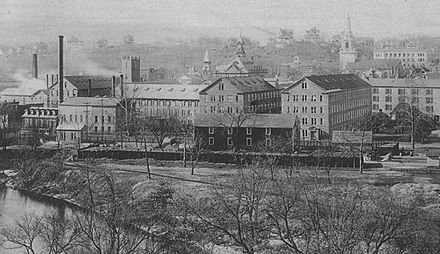
Amazon octopus keep stretching out its arms
Goodyear Metallic Rubber Shoe Company and downtown Naugatuck (c. 1890). The many industrial firms in Naugatuck and Waterbury in the communities’ industrial heyday, from the mid-19th Century through the 1960’s, dumped toxic waste into the Naugatuck River, much of which eventually flowed into Long Island Sound.
From The New England Council (newenglandcouncil.com):
“Amazon plans to develop a new distribution facility in New Haven County, Conn….Bluewater Property Group, a developer from Pennsylvania, has begun taking steps to create a tremendous Amazon distribution facility on the border of Waterbury and Naugatuck.
“Though the development is far from completion and is awaiting approval, residents of Waterbury and Naugatuck and members of the Connecticut (congressional) delegation are optimistic about the prosperity that this facility would bring to the county, and even the state.
“‘It has the potential to create up to 1,000 new jobs and go a long way in supporting these communities in their broader revitalization efforts,’ stated Connecticut Gov. Ned Lamont. U.S. Rep. Jahana Hayes shared in this assertion, stating that this influx of jobs would benefit the middle class and the blue-collar workers in the area.’’
'The Trout Pool Paradox'
The Housatonic River in Cornwall, Conn., on the edge of the Berkshires
“Right here at my feet is what I’ve come to think of as the trout pool paradox….The trout pool is a place for solitary contemplation, for romantic love, for a sense of reconnection with lost wilderness. And yet paradoxically, the pristine trout pools of western Connecticut nurtured the most noisome and alienating developments of the American industrial revolution – factory towns, foundries, mass production, the modern armaments and aerospace industries.’’
-- From The Trout Pool Paradox: The American Lives of Three Rivers, by George Black. The book explores the histories of the Housatonic River and two of its tributaries — the Naugatuck, which for a long time was a dumping place for toxic industrial byproducts and human waste, and the Shepaug, known for its fine fishing. The editor of this site, Robert Whitcomb, lived near the Naugatuck in the ‘60s and remembers the river often changing colors depending on what the factories along it were dumping and pouring directly into it, much of it poisonous in varying degrees.
Trout fishing with fly rods became popular in New England in the 19th Century even as industrialization began to pollute many of them of the region’s streams.





